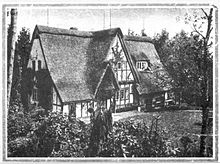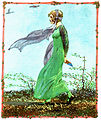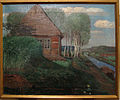Walter Schulze (architect)
Walter Heinrich Karl Schulze , also Walther Heinrich Karl Schulze (born August 7, 1880 in Beuthen (Upper Silesia) , † after 1916) was a German architect and painter .
Life
He spent his childhood in Beuthen / Upper Silesia. His father, August Schulze, ran studios as a photographer in Beuthen , Gleiwitz and Bunzlau . In 1903 and 1904 he studied painting and perspective drawing at the “Royal Academic University for the Fine Arts” in Berlin-Charlottenburg, a. a. with the landscape painter Prof. Wilhelm Herwarth. In 1906 Walter Schulze worked for Isadora Duncan's dance school in Berlin for avant-garde expressive dance . On Sunday mornings, the students drew outdoors under his guidance and practiced observing nature. With his design of an “air bath dress”, which was also used in the Duncan School, Walter Schulze took part in the development of body-friendly reform clothing. In July 1906 he married the art student Johanna Emilie Therese Lange in (Berlin-) Friedenau. The witnesses were the painters Heinrich Richter-Berlin and Kurt Hermann Rosenberg, who had studied with him at the same art academy - both members of what would later become the Novembergruppe artists' association .
In autumn 1906 he moved with her and the painter Ilse Hahn to Worpswede , initially lived in the farmhouse in Westerwede where Rainer Maria Rilke had previously lived and settled there as an independent architect. During this time Heinrich Vogeler employed him as an employee (as draftsman and architect) - probably until 1912. In 1907 he built his house with a thatched roof on the Worpsweder Weyerberg - with a spacious, multifunctional interior. This interior design meant - in the context of the life reform movement - a farewell to the " good room " that had been customary up until then . The unconventional design of the floor plan created a multi-purpose space that was suitable both as a kitchen-living room and as a place to stay for the family. Such a floor plan should also be suitable for rural workers' houses, in which more space could be gained for the mostly overcrowded bedrooms by eliminating the "living room" common in bourgeois houses. This house burned down completely in November 1908, but was rebuilt by Walter Schulze in the same place in 1909. Heinrich Vogeler also discussed this particular interior design of his employee in his autobiography; With him, Walter Schulze developed a building method that strives for a symbiosis of modern urban architecture with regional building methods. In collaboration with him, he realized various construction projects, including several stations for the Kleinbahn Moorexpress . In October 1910, the Worpsweder Beautification Association awarded a prize to Walter Schulze's designs for the train stations. In 1909 the son Kurd Jürgen was born. When Heinrich Vogeler traveled to Paris for two months in the spring of 1911, Walter Schulze replaced him at the Barkenhoff. After the end of his employment with Heinrich Vogeler, he went to Berlin in 1912. He sold his house in Worpsweder Lindenallee in 1913 to the industrialist Wilhelm Garvens for his son, the art dealer Herbert von Garvens - probably through Vogeler. He then designed several buildings as an architect in Worpswede / Ostendorf, Fischerhude and Berlin. His marriage to Johanna Schulze, who served as a model for Vogeler several times, was divorced in Berlin in 1915. His brother Alfred Schulze , who was six years his junior, also worked as a draftsman and architect in Worpswede from 1909. Walter Schulze was also active as a painter in Berlin and Worpswede.
In 1916 he wrote several letters to Martha Vogeler from which it emerges that he was a soldier on the Western Front in the Battle of the Somme . He served in Feldfliegerabteilung 22, probably in the aerial photography unit.
"Physically, I feel very good when I am not always haunted by the madness of this war ..."
Clear documents are still lacking about his further fate such as the time, place and reason for his death. The Worpswede writer Edwin Koenemann mentions in his detailed diary in June 1918 that he had heard that Walter Schulze had been taken to an asylum for "softening of the brain". Koenemann later mentions he died in a madhouse in May 1928. Apart from these third-hand notes, there is no concrete evidence so far. The location of this institution is also unknown.
plant
Buildings and designs
- 1907: own house in Worpswede (burned down in 1908, rebuilt, listed )
- 1909–1910: Entrance building of the Worpswede train station , together with Heinrich Vogeler
- 1910: Conversion of an old Lower Saxony house to the Weyerdeelen-Umbeck stop of the Bremervörde-Osterholzer Railway (not preserved)
- 1912–1913: House in Berlin-Frohnau (1928 by Paul Poser , listed)
- 1914: Single-family house for Johanna Westhoff, the mother of Clara Rilke-Westhoff, in Fischerhude near Bremen
- 1914: Dorothea Schmidt gymnastics school in Berlin-Grunewald (not preserved)
- 1914–15: Single-family house with thatched roof in Worpswede / Ostendorf (Am Schmidtberg)
Paintings, drawings, photos
Fonts
Schulze, Walter: air bath dress. In: Karl Vanselow (ed.): The beauty. Fourth volume, 4th issue. p.223-225. Verlag die Schönheit, Berlin. 1906
literature
- Karl-Robert Schütze: A “Worpswede architect” in the Vogeler environment. Walter Schulze built in Fischerhude and Berlin. In: Between Elbe and Weser , Volume 30, 2011, No. 3, pp. 8–11.
Individual evidence
- ^ University archive of the UdK Berlin, holdings 6/41 and 203
- ^ Association prospectus of the Duncan School Berlin
- ↑ Ilse Störmer remembers her time in Worpswede. Written down by Bettina-Müller-Vogeler, 1960. In: P. Elze, B. Nachtwey (Ed.): Heiteres Worpswede. Art of one's own free will. Worpsweder Verlag, 1994.
- ↑ Walter Schulze: Air bath dress. In: Karl Vanselow: The Beauty. Fourth volume, 4th issue, pp. 222-224. Publishing house "Die Schönheit" Berlin 1906.
- ↑ marriage certificate Walter HK Schulze and Johanna ET Lange; Berlin-Friedenau 1906
- ^ Heinrich Vogeler: Becoming. Verlag Atelier im Bauernhaus, Fischerhude 1989, pp. 143–144 and p. 511.
- ↑ Bettina Müller (née Vogeler) wrote in her memoirs on April 1, 1983 : “Two Schulze brothers came to Worpswede. Walter Schulze as an employee for architecture worked for Heinrich Vogeler. … “In: Bettina Müller, Diary / Memories. Unpublished Manuscript. Archive " Haus im Schluh ". 1983.
- ↑ Source: Osterholz-Scharmbeck real estate cadastre
- ↑ Heike Albrecht: Artists change a village. In: Helmut Stelljes (Ed.) Kulturzeichen. Worpsweder lectures. Publisher M. Simmering. Lilienthal 1993. p. 244
- ↑ Source: Letter from Heinrich Vogeler to Otto Modersohn of November 22, 1908; Worpsweder Archive, Worpswede
- ↑ Ilse Störmer remembers her time in Worpswede. Written down by Bettina Müller-Vogeler, 1960. In: P. Elze, B. Nachtwey (Ed.): Heiteres Worpswede. Art of one's own free will. Worpsweder Verlag, 1994.
- ↑ Karl Robert Schütze, Peter Elze: The Moorexpress. Worpsweder Verlag, 1984, p. 60.
- ↑ Source: Protocol book of the Worpswede Improvement Association. Friends of Worpswedes e. V.
- ^ Edwin Koenemann's diary, excerpt from April 1, 1911. Archive of the association “Freunde Worpswedes e. V. "
- ^ Edwin Koenemann's diary, March 30, 1913, Archives of the Friends of Worpswedes eV
- ^ Letter from Heinrich Vogeler to Herbert von Garvens, Worpswede, December 30, 1913. Hannover City Library, Frank Wedekind Collection
- ^ Edwin Koenemann's diary, June 16, 1913, Archiv der Freunde Worpswedes eV; Land registry office Osterholz-Scharmbeck
- ^ Karl-Robert Schütze: An architect in Worpsweder in the Vogeler environment. Walter Schulze built in Fischerhude and Berlin. In: Between Elbe and Weser, Volume 30, 2011, No. 3 (from July 2011), pp. 8–11.
- ↑ four letters from Walter Schulze to Martha Vogeler, dated April 20, 1916, April 30, 1916, July 8, 1916 and July 30, 1916. Worpsweder Archive; Worpswede.
- ^ Edwin Koenemann's diary, excerpts from June 20, 1918 and May 24, 1928. Archive of the association “Freunde Worpswedes e. V. "
- ^ Wolfgang Saal: Village image and artist architecture. In: Worpswede. 100 years of the artists' colony. Worpsweder Verlag, 1989, p. 187 f.
- ↑ Worpsweder train station. May 19, 2013, accessed April 27, 2014 .
- ↑ http://www.stadtentwicklung.berlin.de/cgi-bin/hidaweb/getdoc.pl?DOK_TPL=lda_doc.tpl&KEY=obj%2009012220
- ^ Karl-Robert Schütze: An architect in Worpsweder in the Vogeler environment. Walter Schulze built in Fischerhude and Berlin. In: Between Elbe and Weser , Volume 30, 2011, No. 3 (from July 2011), pp. 8–11.
- ^ Karl-Robert Schütze: Gymnastics School Dorothea Schmidt - Dorotheenstiftung - Dorotheenbund e. V. Securing evidence. In: Yearbook of the Berlin State Archives 2012. pp. 131–163.
- ^ Source: Letter from W. Schulze to Martha Vogeler, July 1916 (see above); Land registry office Osterholz-Scharmbeck
| personal data | |
|---|---|
| SURNAME | Schulze, Walter |
| ALTERNATIVE NAMES | Schulze, Walter Heinrich Karl (full name); Schulze, Walther Heinrich Karl |
| BRIEF DESCRIPTION | German architect and painter |
| DATE OF BIRTH | August 7, 1880 |
| PLACE OF BIRTH | Beuthen (Upper Silesia) |
| DATE OF DEATH | after 1916 |








